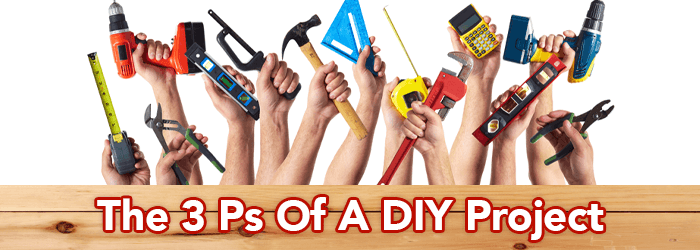Safety Precautions, Planning, and Preparation For Your Next DIY Project
Since 1988, we have produced and offered hundreds of videos, blogs, and on-air advice to hundreds of thousands of homeowners across this great state. Let’s take a step back to the beginning and review some very important and often overlooked steps in starting your Do-It-Yourself project.
Precautions
While safety is always a priority, the focus here is on assessing the projects you should tackle and the ones you should not. Rosie has often said, “Understand the expectations of the party you are working for.” That could be you, a spouse, or a partner. The point is for you to make a truthful and realistic assessment of your skill level. Read this blog about what not to tackle.
Starting a DIY project that you have not done before requires more than courage. You must consider your skill set while putting the ol’ ego aside. Then you need to plan.
Planning

You have decided to take on a project. You have assessed your skill set and determined what you need to learn. What’s next? It is time to study, and study you must. As stated earlier, Rosie and Romey have produced many “How-To” videos and blogs, which are available on our website. That would be an ideal place to start. Research your project. Learn enough about the steps you need to go through before starting. This is not the time for
adventure and discovery. Consult professionals or others you know who have done what you are planning to do. Their answers will save you time, money, and frustration.
Consider your budget. Determine how much you want to spend. Give yourself a little wiggle room when you do. As you think about your budget, also consider your Return On Investment or ROI. Remodeling Magazine has a helpful cost vs. value report. If you just want to do the project for yourself or your family, then don’t let such information dissuade you from moving forward.
Draw out your project. Measure the space and use graph paper. A one-eighth inch or one-quarter inch grid will help you keep the scale accurate. Make sure the walls, ceilings, and floors are plum, level, and square. Lay out the project on the floor if appropriate. Use blue painter’s masking tape for walls and built-in objects. This will help you visualize the space and allow you to make any corrections ahead of time, like not leaving enough room for the cabinet and walking space.
Make a comprehensive list of all the materials you will need. Include all the items you will need to attach, affix, and finish all the materials you will be using. An example is drywall. You need to get enough boards, screws, or nails to attach the boards to the framing, drywall compound to finish, and covering such as paint and wallpaper. This list will probably be fairly long and well thought out. As you create the list, more tasks or items will come to mind and help you prepare for the work.
Next up is determining what tools you will need. Rosie has a lot of suggestions. What you should consider here are any special tools you might need. Spend a little time walking around the tool section in your favorite hardware store and check out our eStore. Looking at what is available will help you make sure you will have the right tool for the job when the time comes.
With good planning under your belt, it’s time to prepare.
Preparations

At this stage, you should be confident that you have researched, studied, and planned well and are now ready to start the process by purchasing what you will need. Just a bit more research is needed. Some call it “shopping.” Look around for quality products, pricing, and in today’s climate, availability. Ask questions about the stock. You don’t want to be short three tiles only to find out they are discontinued.
For items you will need to order, which may mean everything on your list, determine lead times. Do this before you begin construction. You don’t want to take on a project thinking you can order something later. The supply chain these days is still a challenge. Get your materials and tools in hand before you start. There are enough horror stories out there about products being delayed months, causing a home to be torn up and the homeowner unable to complete what was started.
Remember the three P’s: Precautions, Planning, and Preparation. This process may take some time upfront but will save you a lot of time later down the road.
###
PODCAST
Before you tackle a home project yourself, learn about the 3 P’s: Planning like your skill set and budget. Preparation includes securing the items needed and time to commit to the project. Precautions on accessing the projects you should tackle and ones to avoid. Plus more of Rosie’s ‘think abouts’! (Live Broadcast From The SAHBA Home Show in Tucson!)
Podcast Archive With Expanded Content and Resources
PHOTO CREDIT
- Shutterstock




















